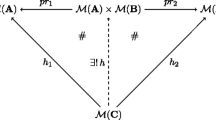Abstract
We continue our studies of the foundation of probability theory using elementary category theory. We propose a classification scheme of probability domains in terms of cogenerators and their algebraic and topological properties and use the scheme to describe the transition from classical to fuzzy probability. We show that Łukasiewicz tribes form a category of natural probability domains in which σ-fields of sets are “minimal” and measurable [0,1]-valued functions are “maximal” objects. The maximal objects form an epireflective subcategory in which both the classical and fuzzy probability can be modelled. This leads to a better understanding of the transition.
Similar content being viewed by others
References
Adámek, J.: Theory of Mathematical Structures. Reidel, Dordrecht (1983)
Bugajski, S.: Statistical maps I. Basic properties. Math. Slovaca 51, 321–342 (2001)
Bugajski, S.: Statistical maps II. Operational random variables. Math. Slovaca 51, 343–361 (2001)
Chovanec, F., Kôpka, F.: D-posets. In: Engesser, K., Gabbay, D.M., Lehmann, D. (eds.) Handbook of Quantum Logic and Quantum Structures: Quantum Structures, pp. 367–428. Elsevier, Amsterdam (2007)
Chovanec, F., Drobná, E., Kôpka, F., Nánasiová, O.: Conditional states and independence in D-posets. Soft Comput. 14, 1027–1034 (2010)
Chovanec, F., Frič, R.: States as morphisms. Int. J. Theor. Phys. 49, 3050–3060 (2010)
Di Nola, A., Navara, M.: A characterization of σ-complete MV-algebras with enough states. Colloq. Math. 103, 121–130 (2005)
Dvurečenskij, A., Pulmannová, S.: New Trends in Quantum Structures. Kluwer Academic, Dordrecht (2000)
Frič, R.: Łukasiewicz tribes are absolutely sequentially closed bold algebras. Czechoslovak Math. J. 52, 861–874 (2002)
Frič, R.: Remarks on statistical maps and fuzzy (operational) random variables. Tatra Mt. Math. Publ. 30, 21–34 (2005)
Frič, R.: Extension of domains of states. Soft Comput. 13, 63–70 (2009)
Frič, R.: Simplex-valued probability. Math. Slovaca 60, 607–614 (2010)
Frič, R., Papčo, M.: On probability domains. Int. J. Theor. Phys. 49, 3092–3100 (2010)
Frič, R., Papčo, M.: A categorical approach to probability. Stud. Log. 94, 215–230 (2010)
Frič, R., Papčo, M.: Fuzzification of crisp domains. Kybernetika 46, 1009–1024 (2010)
Goguen, J.A.: L-fuzzy sets. J. Math. Anal. Appl. 18, 145–174 (1967)
Gudder, S.: Fuzzy probability theory. Demonstr. Math. 31, 235–254 (1998)
Kôpka, F., Chovanec, F.: D-posets. Math. Slovaca 44, 21–34 (1994)
Kroupa, T.: Conditional probability on MV-algebras. Fuzzy Sets Syst. 149, 369–381 (2005)
Loève, M.: Probability theory. Nostrand, Princeton (1963)
Mesiar, R.: Fuzzy sets and probability theory. Tatra Mt. Math. Publ. 1, 105–123 (1992)
Navara, M.: Probability and conditional probability on tribes of fuzzy sets. In: Dubois, D., Klement, E.P., Mesiar, R. (eds.) Fuzzy sets, Probability, and Statistics–Gaps and Bridges. Johannes Kepler University, Linz, Austria, pp. 84–88 (2007)
Navara, M.: Tribes revisited. In: Bodenhofer, U., De Baets, B., Klement, E.P., Saminger-Platz, S. (eds.) 30th Linz Seminar on Fuzzy Set Theory: The Legacy of 30 Seminars—Where Do We Stand and Where Do We Go? Johannes Kepler University, Linz, Austria, pp. 81–84 (2009)
Papčo, M.: On measurable spaces and measurable maps. Tatra Mt. Math. Publ. 28, 125–140 (2004)
Papčo, M.: On fuzzy random variables: examples and generalizations. Tatra Mt. Math. Publ. 30, 175–185 (2005)
Papčo, M.: On effect algebras. Soft Comput. 12, 373–379 (2008)
Rényi, A.: Foundations of Probability. Holden-Day, San Francisco (1970)
Riečan, B., Mundici, D.: Probability on MV-algebras. In: Pap, E. (ed.) Handbook of Measure Theory, Vol. II. North-Holland, Amsterdam, pp. 869–910 (2002)
Riečan, B., Neubrunn, T.: Integral, Measure, and Ordering. Kluwer Academic, Dordrecht (1997
Rodabaugh, S.E.: Categorical foundations of variable-basis fuzzy topology. In: Höhle, U., Rodabaugh, S.E. (eds.) Mathematics of Fuzzy Sets: Logic, Topology and Measure Theory, The Handbooks of Fuzzy Sets Series, vol. 3, pp. 273–388. Kluwer Academic, Dordrecht (1999)
Author information
Authors and Affiliations
Corresponding author
Rights and permissions
About this article
Cite this article
Frič, R., Papčo, M. On Probability Domains II. Int J Theor Phys 50, 3778–3786 (2011). https://doi.org/10.1007/s10773-011-0855-2
Received:
Accepted:
Published:
Issue Date:
DOI: https://doi.org/10.1007/s10773-011-0855-2




